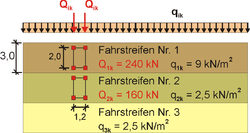Payload (construction)
The payload (formerly also traffic load ; in the English live load ) refers to the civil engineering a variable or moving exposure to a component, for example as a result of people, lighting equipment, stored materials, machinery or vehicles.
The intensity of the payload is stochastic . In particular, sudden changes at any point in time as well as extremely high values for a short time can occur.
In contrast to the permanent loads , the traffic loads are only taken into account in the static calculation if they have an unfavorable effect on the verification to be carried out .
Buildings
The calculated values of the evenly distributed payloads are determined according to the division of the usable areas into usage categories . This records long-term loads such as stationary furniture and short-term loads such as stacked goods or unusual concentrations of people, as well as normal machine loads.
| category | use | Examples |
Surface load qk ( kN / m ²) |
Single load Qk (kN) |
|
|---|---|---|---|---|---|
| A. | A1 | Pointed floors | Roof space up to 1.8 m clear height | 1.0 | 1.0 |
| A2 | Living rooms and lounges |
Rooms and corridors in residential buildings, hotel rooms |
1.5 | 1.0 | |
| A3 | Living rooms and lounges | like A2, but without sufficient lateral distribution | 2.0 | 1.0 | |
| B. | B1 | Office space, work space | Office space, stables for small cattle | 2.0 | 2.0 |
| B2 | Retirement homes, boarding schools | 3.0 | 3.0 | ||
| T | T1 | Stairs and landings | Category A stairs and landings | 3.0 | 2.0 |
| T2 | Category B to E stairs and landings | 5.0 | 2.0 | ||
| Z | Balconies | Roof terraces, loggias, balconies | 4.0 | 2.0 | |
Road bridges
The assumed payloads on road bridges are represented by load models . The most important load model 1 consists of double-axle loads (TS load) and evenly distributed area loads (UDL load) for the effects of heavy goods vehicles and passenger cars . The modeling and calibration was carried out through statistical evaluations of the traffic on selected roads and associated traffic load simulations.
Until 2003, the road and path bridges were divided into bridge classes according to the then valid DIN 1072 depending on the load capacity. The highest bridge class was 60/30, i.e. H. In addition to evenly distributed area loads, a heavy-duty truck with a total load of 60 t (SLW 60) was to be placed on the main lane and a total load of 30 t in the adjacent lane.
In Germany, additional load models result from the military load class for which the bridge is to be designed when specified by the client.
| class | Caterpillars | Wheeled vehicles |
|---|---|---|
| 40 | 36.3 t | 42.6 t |
| 50 | 45.4 t | 52.6 t |
| 80 | 72.6 t | 83.5 t |
| 100 | 90.7 t | 104.3 t |
| 120 | 108.9 t | 125.2 t |
Pedestrian bridges
For pedestrian and cycle path bridges, according to DIN Technical Report 101, a surface load of 5 kN / m² is to be assumed as the payload. This can be reduced for spans of more than 10 m depending on the span. The lower limit for spans greater than 210 m is a payload of 2.5 kN / m².
Railway bridges
For normal-gauge rail traffic in Germany, the load model 71 is to be used on routes with normal traffic, which is identical to the load model UIC 71. This corresponds to the meter loads of route class D4.
Additional load models must be observed for routes with heavy traffic. Such load models for the determination of the relevant forces to bring in the most unfavorable load position, which for itself. B. can be determined with the help of influence lines .

